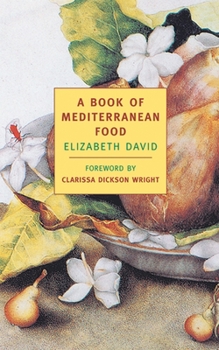A Book of Mediterranean Food
Select Format
Select Condition 
Book Overview
A classic 1950 cookbook featuring Mediterranean recipes and lore.Long acknowledged as the inspiration for such modern masters as Julia Child and Claudia Roden, A Book of Mediterranean Food is... This description may be from another edition of this product.
Format:Paperback
Language:English
ISBN:1590170032
ISBN13:9781590170038
Release Date:April 2002
Publisher:New York Review of Books
Length:222 Pages
Weight:0.55 lbs.
Dimensions:0.5" x 5.1" x 8.0"
Customer Reviews
3 ratings
Great book!
Published by Thriftbooks.com User , 19 years ago
I love Elizabeth David; I turn again and again to her books, as every dish I make seems to turn out fantastically!
A Classic
Published by Thriftbooks.com User , 19 years ago
I agree with a previous reviewer that this is not the bast format for a cookbook. You cannot lay it open on the counter to glance at while you go about preparing a recipe. However, I feel that this book is less about recipes and more about technique. If you are the kind of person who enjoys reading cookbooks to learn new techniques to use in the kitchen, this book is very useful. If you want a book to prop up on the counter while you cook, it is not. I would also note that "A Book of Mediterrenean Food" is a good source of culinary history and an interesting read if you want to know more about where dishes have come from. Many of the recipes are very simple, with few ingredients. Having read her recipe for Gazpacho, I can tell that it is wholely different than the Gazpacho that I am use to making - there is very little seasoning, and the recipe relies less on herbs and spices and more on the natural flavors of the ingredients - and to prepare Ms. David's recipe will require extremely fresh, high quality vegetables. This appears to be true of many of the recipes in this book. I thoroughly enjoy Ms. David's writing. She is sharp and witty, even writing about something as mundane as soup. I am very happy that I purchased this book, and I'm sure that I will refer back to it for recipes and techniques for a long time.
Literate Fountainhead of Much Culinary Writing
Published by Thriftbooks.com User , 20 years ago
This volume is one of the very few culinary titles published over fifty years ago, which is not only still in print, but still influencing how people think about food. To understand the importance of the book, it is more than usually important to place it in context, in the England of 1950 which was just coming out of six years of World War II followed by four years of rationing austerity, when a pound of butter was difficult to find and olive oil was sold by the pint in apothecaries `for external use only'.Complimentary blurbs from Alice Waters can be found on many books nowadays, but this one I know is more heartfelt than usual. Based on Jeremiah Tower's recent memoir, I know David influenced both Waters and Tower. She was also a major influence on later writers on Mediterranean cuisine such as Claudia Roden and Paula Wolfert.David's notion of Mediterranean cuisine is somewhat limited to the western and central European coasts of Spain, France, Italy, and Greece, even though David did live and work in Egypt during World War II. Even here, she seems to color outside the lines a bit, reaching as far north and west as Lyon and Bordeaux. There is little here from North Africa. There is not even a mention of couscous in the index. To remedy this deficiency, David refers us to Claudia Roden's excellent book on Near Eastern food.I can imagine that the recipes, foodstuffs, and stories of the Mediterranean shores had much the same influence on post-war Londoners as Provence had on the painting of Cezanne. David's word pictures brought the bright light and blue seas into the London parlors and stirred an interest, which had been dormant for over 10 years. The evidence of this was that, against all expectations, the book sold very well in 1950 and it has been reissued with new introductions in 1958, 1065, 1988, and 2002, the last time with the Foreword by Clarissa Dickson Wright of `Two Fat Ladies' fame.David's recipe writing is very much tied to her times and her English public school and university education. There is no hint of food processor or blender, let alone microwave. All purees are done with mortar and pestle. For those who are not familiar with this venerable tool, let me assure you that with little effort, if will often give equal or better results than the electric gizmos of today, especially with classics such as aioli and pesto. Just check out the pleasure Jamie Oliver shows in using it. The style of recipe writing may also be unfamiliar. David is assuming that the reader is a knowledgeable cook. She takes for granted, for example, that you know how to peel tomatoes and cook potatoes for salads or puree. Most directions are spare. Ms. Wright testifies that she often uses them as reminders of how to write a concise recipe.The names of things may also be unfamiliar. Eggplants are called aubergines and porcini mushrooms are called cepes. These were not hard, but the reference to marrows (courgettes) sent be scurrying to the Larousse Gastronom






